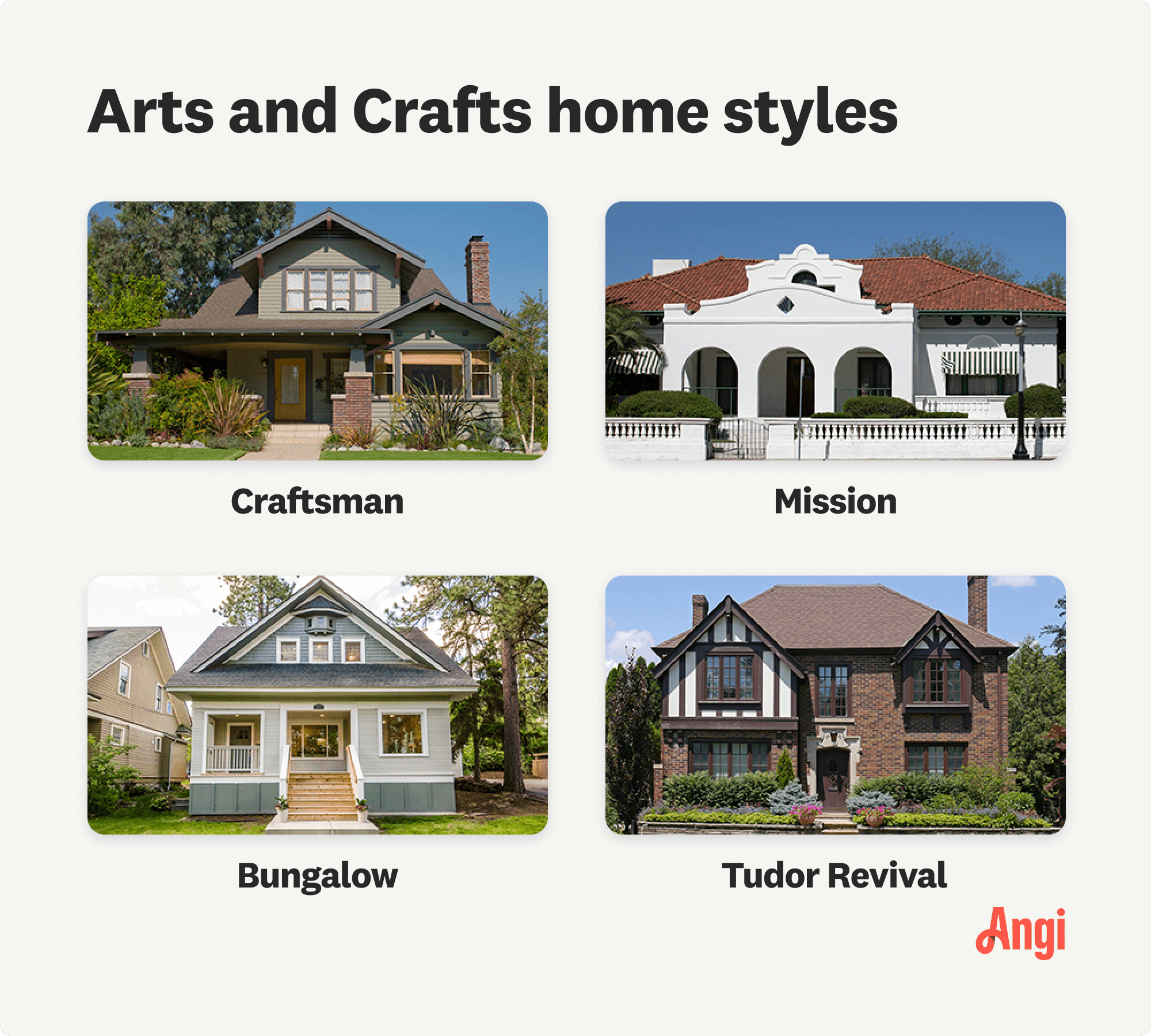
The cost to convert a vaulted ceiling to a second floor depends on factors such as its size, intended function, materials, and the project's complexity.
The term "arts and crafts" is not just for summer camp


The Arts and Crafts movement inspired a range of American architectural styles.
The philosophy focuses on handmade craftsmanship, fine materials, and an appreciation for nature.
The homes often include front porches, open floor plans, and built-in elements.
The interior design offshoot showcases finely made furniture, natural patterns, and high-quality materials.
The Arts and Crafts movement of the late 19th century may leave you thinking, "Hey, that sounds familiar." Between the Industrial Revolution and the rise of fast and flashy Victorian architecture, a group of artists craved a return to simplicity, craftsmanship, and quality materials. Much like today's rebuke of fast fashion and appreciation for rustic farmhouse design, the Arts and Crafts movement called for a return to easily maintained architecture, intentional interior design, and even a simpler way of life.
Long before the architectural style crossed the pond to the U.S., the Arts and Crafts movement started as a social mindset. The working class in England had primarily transitioned to large cities during the Industrial Revolution, often pushed into overcrowded and poorly built buildings.
These conditions inspired writers, activists, and home designers to push back. The Arts and Crafts movement celebrated a return to nature, family life, and an appreciation for handmade goods.
By the early 20th century, Arts and Crafts societies popped up across the U.S. and inspired the craftsman and bungalow-style homes and an interior design movement. While the style dwindled after World War I, many finely crafted homes stand today. The movement is even making a comeback as a return to handmade goods makes another resurgence.
It's easy to mix up a craftsman house with an Arts and Crafts-style home. And while they are incredibly similar, they are not exactly the same.
Think of it this way: The Arts and Crafts movement inspired the craftsman house. But you will find Arts and Crafts-style elements in everything from bungalows to ranch homes. The Arts and Crafts features are best displayed in a craftsman, but it's just one example of the larger movement.
The Arts and Crafts style may not be as easy to pinpoint as, say, a Chalet-style home or a shotgun home. It is more likely that you will find elements of the early 20th century that stemmed from general philosophy. Let's clarify what we mean.
Arts and Crafts design allowed working and middle-class homeowners to thrive in well-made, low-maintenance homes. Homebuilders often chose fine building materials like oak, red brick, and natural stone for their construction. A series of low-pitched roofs with overhanging eaves, multiple fireplaces, and well-placed windows complemented the local climate.
Additionally, an Arts and Crafts home showed off its fine materials. Exposed rafters, wood beams, and hardwood floors provided a natural farmhouse quality. Metalworkers could also showcase their skills in cast-iron or steel accents.
If you've ever daydreamed about built-in bookshelves and a front porch bench, this style is for you. An Arts and Crafts home is functional and encourages easy use for the whole family. Built-in furniture made another move to show off the craftsmanship of its designer.
In the same theme, the floor plan of this style celebrated a central gathering space. The primary living room on the first floor typically focuses on a fireplace. Homeowners had space to transition easily from the kitchen to the dining area. While the homes often have second or third stories, they are less segmented than other 19th and early 20th-century homes of the time.
Nearly all Arts and Crafts architecture features a front porch or back patio. A return to quality meant a return to nature, so homes encouraged their owners to spend time outdoors together. Spacious windows, tall ceilings, and exits into the garden were common.
You can often pick out a bungalow or craftsman home based on its window structure; the top floor often features a single dormer window with a cross-gabled roof. Arts and Crafts homes overall featured multiple windows on the bottom floor. They were often double-hung—and therefore easy to open—and multi-paned.
Additionally, artists could show off their skills by including stained glass in these homes, both in the primary windows and smaller accents on doors.
As we mentioned earlier, the Arts and Crafts architectural movement inspired several styles of homes. Here are several options when you're on the market for a home from this classic time.

Craftsman-style homes include the iconic low, symmetric A-framed roof, open floor plans, and oversized exposed wood beams. Their roofs typically have a low pitch, but you'll find them in both one- and two-story varieties.
Mission architecture combines many elements of the Arts and Crafts style with the Western style. You'll find local building materials, such as terracotta, clay siding, and vibrant tiles, but the shape of the home reflects the symmetrical simplicity similar to a Craftsman. Inside, you'll find built-in furniture, hand-crafted trim, and exposed rafters.
Bungalow-style homes popped up across the country in the early 20th Century, particularly in the Arts and Crafts style. Typically one floor and low on square footage, these cozy cottage-like houses included a low-pitched roof with overhanging eaves. You'll often find a small porch and steps that raise the bungalow off the ground.
Though it may look like a distant relative from most Arts and Crafts homes, Tudor Revival architecture sprung up from the same era. Rebelling against the ornate complexity of Victorian houses, builders turned toward the exposed exterior framing and symmetrical balance of Tudor homes from the 16th Century. The home's white stucco siding and contrasting external beams make them impossible to miss.
If you're on the fence about buying an Arts and Crafts-style home, consider all styles of their ups and downs. While they are typically well-crafted, as the name implies, some of these homes come with a few headaches.
Arts and Crafts style houses are a find on today's market. You'll likely spot the style highlight at the top of a real estate listing. Here are some perks to living in the design:
Likely built with high-quality and long-lasting materials
Built-in furniture such as bookshelves and window seats
Attention to high craftsmanship means that you'll need fewer repairs
The look withstands the test of time and rotating trends
The open floor plan is still a popular option for homeowners today
Sure, higher-quality building materials likely mean a higher cost to build the house in the first place. However, price aside, some sneaky issues are hiding behind these homes' exposed rafters.
Kitchen and bathrooms will likely require significant upgrades for modern appliances
Older homes may require updated electrics, such as if they have knob-and-tube wiring
Some homes are dark due to the comparatively low number of windows
The abundance of wood finished means higher maintenance costs
You may need to hire a historical home specialist to update your home

If you fall in love with the Arts and Crafts movement, you don't have to live in that style home to adopt the lifestyle. Work with a local interior designer to determine which parts of your home can make the switch—from furniture choices to new cabinets.
Oak and other fine woods are a central theme of an Arts and Crafts home. Wood flooring, high-backed dining chairs, and oak doorframes all tie together when you choose the same material. You can also showcase artistry with hand-painted tiles in your bathroom or kitchen by choosing a natural stone countertop.
Some of the original Arts and Crafts designs of the 1850s stem back to floral and other natural patterns. Use these patterns to accent wallpaper, curtains, or upholstery against a simple wooden design.
The Arts and Crafts furniture movement was one of the key ways artists displayed their fine craftsmanship. It often features fine wood, metal, stone, and glass like the homes. Oversized cabinets, tables, and chairs act as the focal point in a room—instead of overuse of ornate decor. Living room seating was over-upholstered and overstuffed for a welcoming look.
Arts and Crafts design may include eye-catching items like wallpaper and crafted furniture, but it is anything but busy. Surfaces are often left clear of decor and clutter unless the item adds to the room's energy.
Floor, table, and built-in lamps have a huge opportunity to set the room's tone while showing off additional artistry. Tiffany lamps are popular accents in these homes, as are cast-iron sconces or chandeliers. Not that you will find a wide range of eras represented in accents like lighting, from Art Decor to mid-century modern.
In line with the movement's original intentions, a living space often faces its furniture toward the central hearth. You'll find more elaborate mantelpieces in Arts and Crafts homes, often featuring wood carvings, tiles, and stonework. Many mantles connect right to built-in bookshelves as well. So, while the mantelpiece decor should remain simple and intentional, the room's layout should showcase its beauty.
If you're building a new home and are hoping to embrace the Arts and Crafts style philosophy, be sure to work with local home builders familiar with the quality-focused style. And remember, many different architectural and interior styles can incorporate this approach; it just takes a bit more time and internal planning.
From average costs to expert advice, get all the answers you need to get your job done.

The cost to convert a vaulted ceiling to a second floor depends on factors such as its size, intended function, materials, and the project's complexity.

Log cabin costs vary depending on the size of the cabin, the location, and the cabin style. This guide will help you figure out the true cost of a log cabin.

Dreaming of building your own home from the ground up? Learn how much it costs to build a house yourself and if it’s worth it to skip the pro on this project.

From early blueprints to the final coat of paint, how long does it take to build a house? Let's walk through what to expect from the home-building timeline.

A villa can be a single-story house or a luxury home with a pool. Here’s a full breakdown of how much it costs to build a villa based on size and style.

Planning and construction takes longer when you don’t follow pre-set plans. Learn how long it takes to build a custom home so that you know what to expect.